This easy recipe for Slow Cooker Beef Bone Broth is made with bones, aromatic vegetables, and plenty of water - that's it!
Perfect in homemade soups, this homemade bone broth recipe is versatile and freezer friendly. Make a big batch and freeze for later!

Jump to:
As someone who has been making broth at home for more than a decade, I have to say one of my favorite ways to make it is in a Crock Pot.
Slow cooker bone broth is not only super easy to make, it's also incredibly flavorful, as the low and slow cooking draws all of the flavor (and minerals) from the bones.
This simple recipe for slow cooker beef bone broth is perfect for beginners, and it's a great way to get started in making your own broth from scratch. Once you start, you're never going to want to use store-bought again!
Reasons to Love This Recipe:
- Easy. Making your own bone broth for the first time can be intimidating, but this slow cooker version is SO simple and practically foolproof.
- Versatile. Homemade beef bone broth can be used in many different ways. It can be used to make soups, gravies, sauces, or for preparing rice.
- Slow and low. Since it cooks for a long time, you won't need to hover over the stove or put off any plans to keep an eye on it.
- All of the benefits of bone broth - but easier. Rich in amino acids, high in collagen and gelatin, good for gut health, and full of minerals (source: Healthline - Bone Broth Benefits)
- Cheaper. Making your own beef broth and chicken broth is a great way to save money at the grocery store. Using something that would otherwise go to waste (bones) and turning it into a flavorful broth is an excellent exercise in thrift and frugality.
Ingredients

- Beef bones: Look for meaty bones with lots of cartilage. Ask your local butcher for "soup bones." This should be a mix of Neck bones, shank, oxtail, short ribs, and knuckles. For the best results, I recommend using bones from grass fed animals, but you can use whatever is available and affordable to you.
- Vegetables/aromatics: You'll need a whole onion, carrots, celery, and garlic. I also like to add mushrooms since they compliment the beef flavor perfectly, but you can leave them out.
- Herbs: Fresh rosemary pairs perfectly with beef, as does a nice whole bay leaf.
- Olive oil: This is for brushing on the bones to help them get brown and toasty (the key to good bone broth!).
- Salt & pepper: Used for seasoning the beef bones before roasting, and added to taste once the broth is finished.
- Apple cider vinegar: Acid helps pull minerals from the bones. If you don't have ACV, some lemon juice or vinegar will do the trick.
- Water: You'll need enough water to fully cover the bones (about 10 cups). I recommend using filtered water, but any drinkable quality water will do!
Equipment
- Strainer: For straining the broth and removing any bits of veggies, herbs, and bones. I recommend using a fine stainless steel mesh strainer, but a colander lined in cheesecloth (or a flour sack towel) will work great in a pinch!
- Slow cooker: I recommend using a 6 quart model, since that fits all of the bones, veggies, and broth without trouble.
- Sheet pan or roasting pan: For roasting the bones before adding them to the crock pot.
Note: I also find using a skimming ladle very helpful when making homemade broths. It's an easy way to skim any foam that rises to the top during the cooking time. I also love it for removing very thin fat layers from soups or broths after chilling.
Instructions


- Add 2 tablespoons of olive oil, salt, and pepper to a small bowl and stir.
- Lay the meaty beef bones on a baking sheet or roasting pan, and brush them with the seasoned oil.

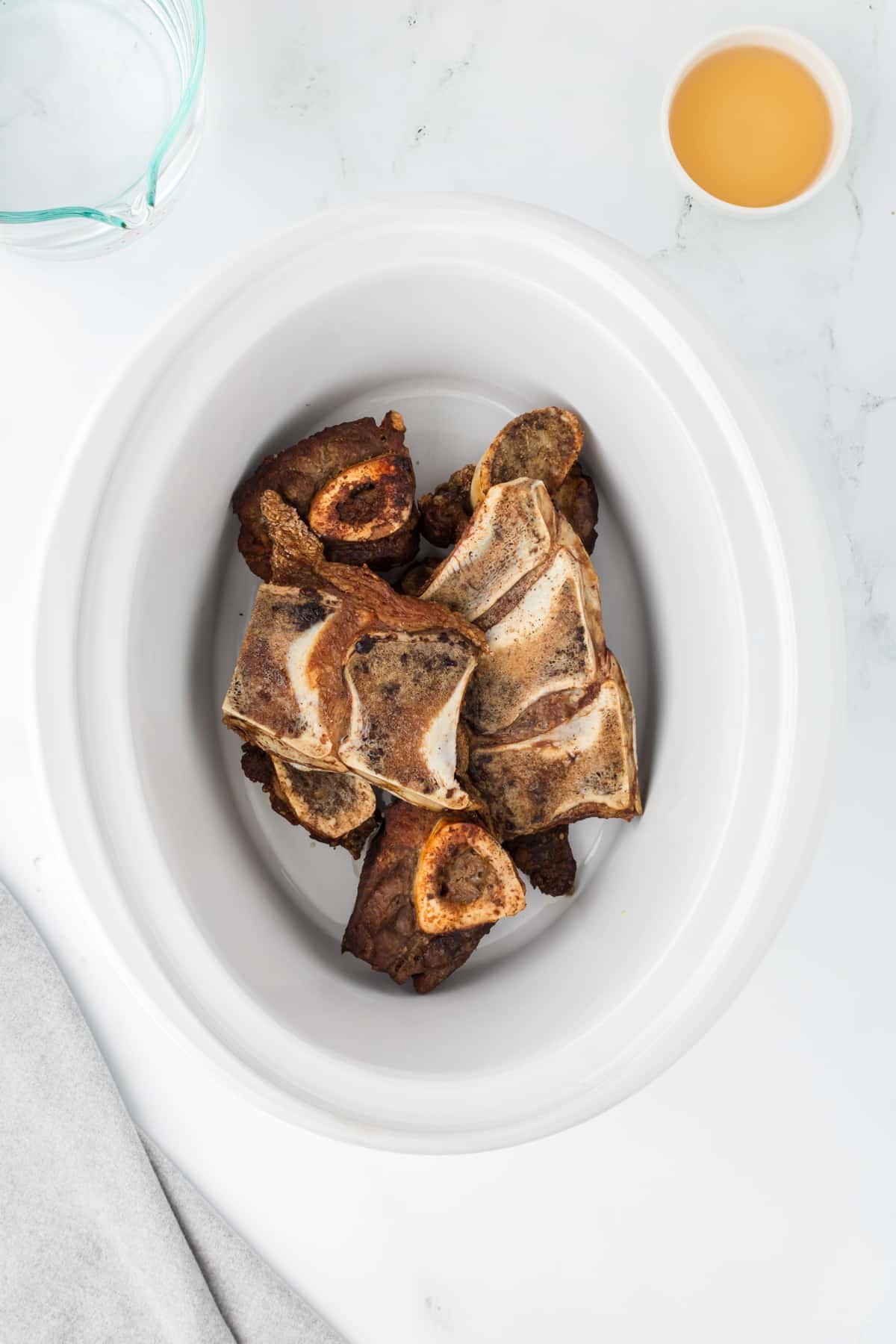
- Roast for 1 hour, or until the bones are dark brown.
- Add your roasted beef bones to the insert of a 6 quart (or larger) slow cooker.

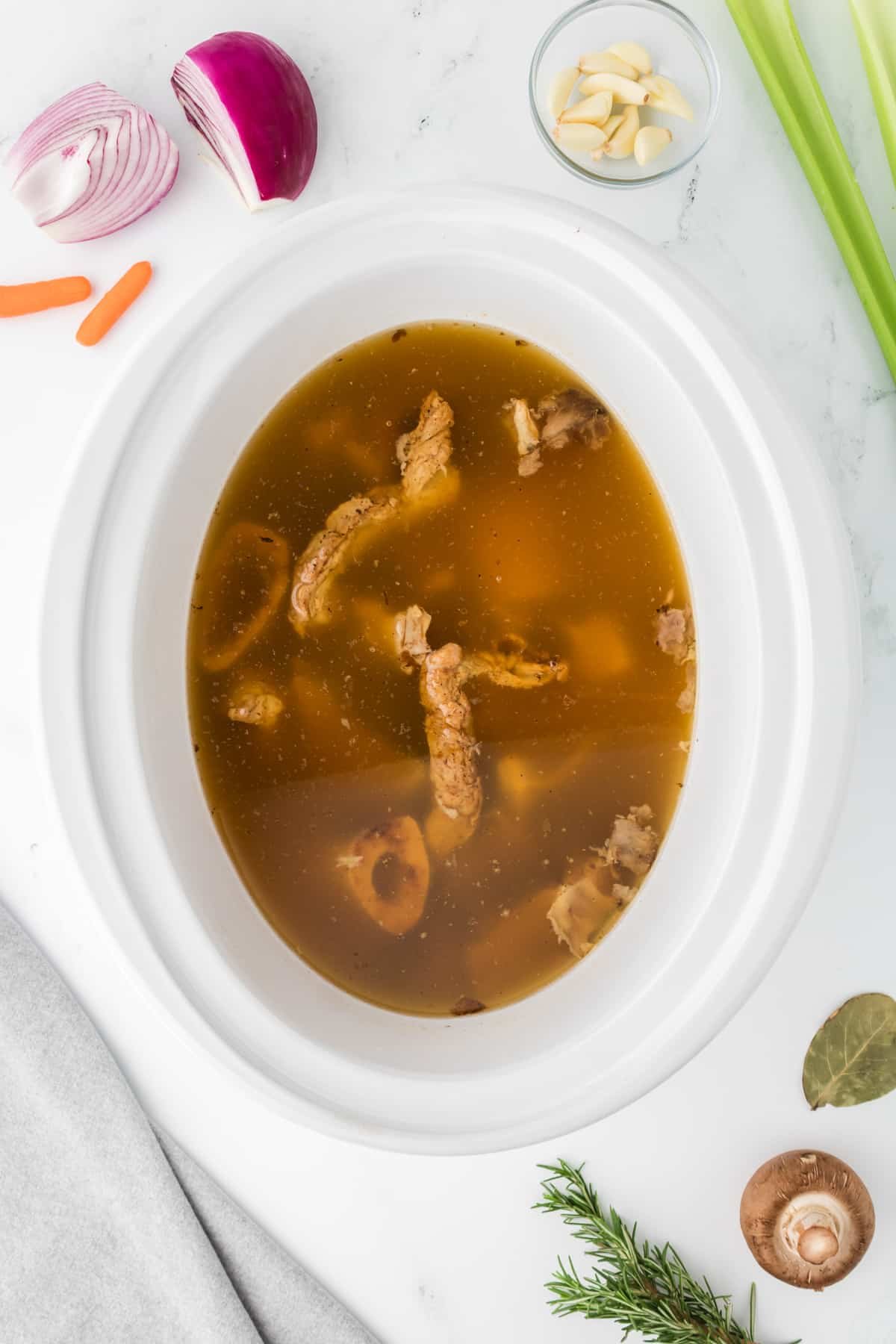
- Cover with filtered water (about 10 cups), and add 2 tablespoons of apple cider vinegar.
- Note: Apple cider vinegar is often used to pull minerals from the bones when making broth.
- Add a lid and cook on "low" for 24 hours.
Adding the Vegetables


- Add the onion, celery, carrots, mushrooms (if using), garlic, rosemary, and bay leaf during the last hour of cooking.
- The vegetables and herbs are added last to prevent any bitter flavors, as some vegetables become bitter when cooked for a long period of time.
Straining the Broth


- Use a skimming ladle or slotted spoon to remove the large pieces of vegetables and bones from the slow cooker.
- Once all of the solids are removed, you're ready to strain your beef broth.
Straining

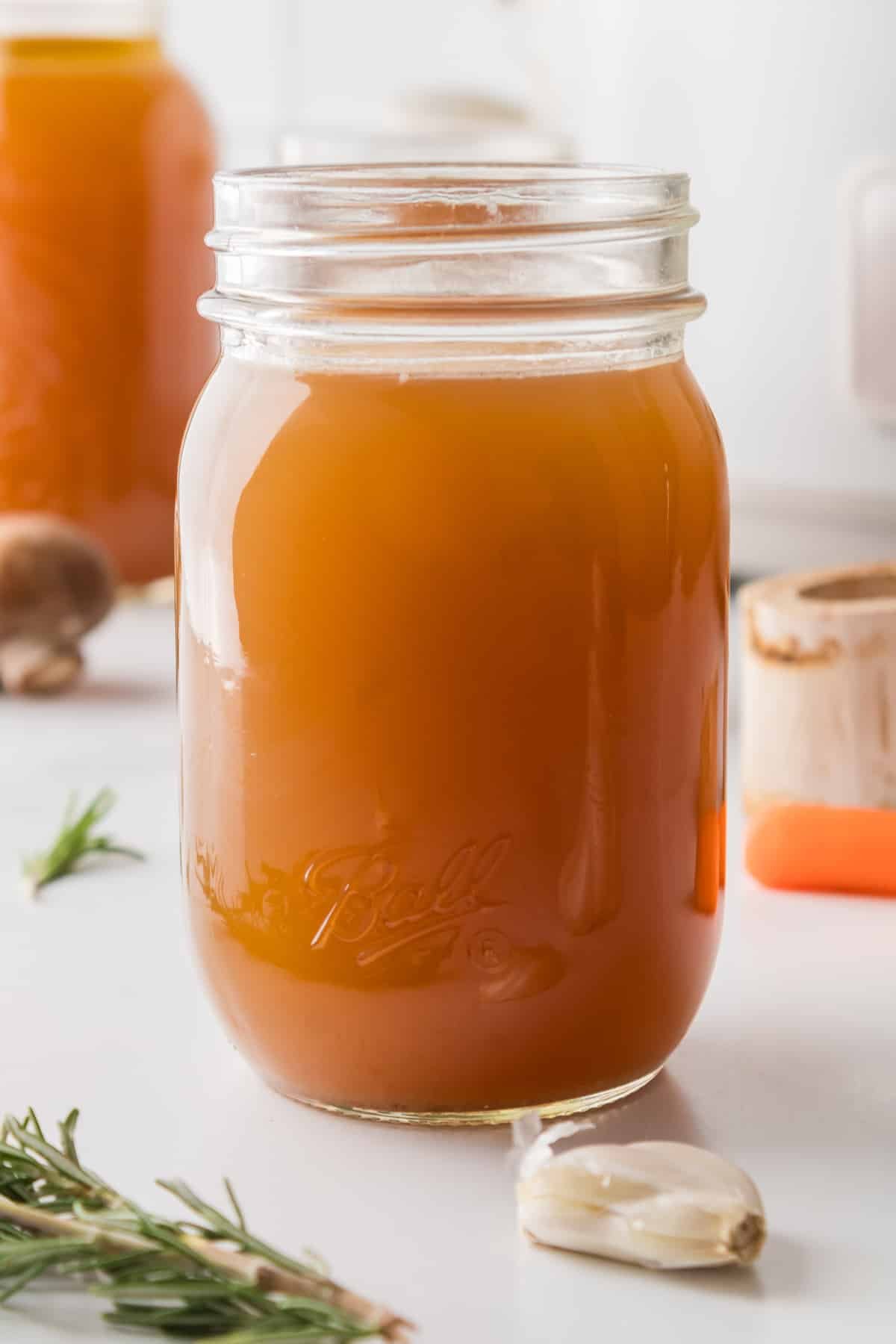
- Set a mesh strainer over a large bowl or mason jar and ladle in the broth.
- Solids and small pieces of herbs will be caught in the strainer, and broth will filter down into the bowl or jar.
- Allow the broth to cool before transferring to the refrigerator to chill.
- Once the broth is chilled you can freeze it, or use it in your favorite recipes.
The Layer of Fat
After bone broth is refrigerated, you will see a solid layer of fat that rises to the top. This is what is referred to as a "Fat cap" and can either be left in place, or removed for a lean broth.
If you remove the fat, you can render it down and use it as you would beef tallow in cooking.
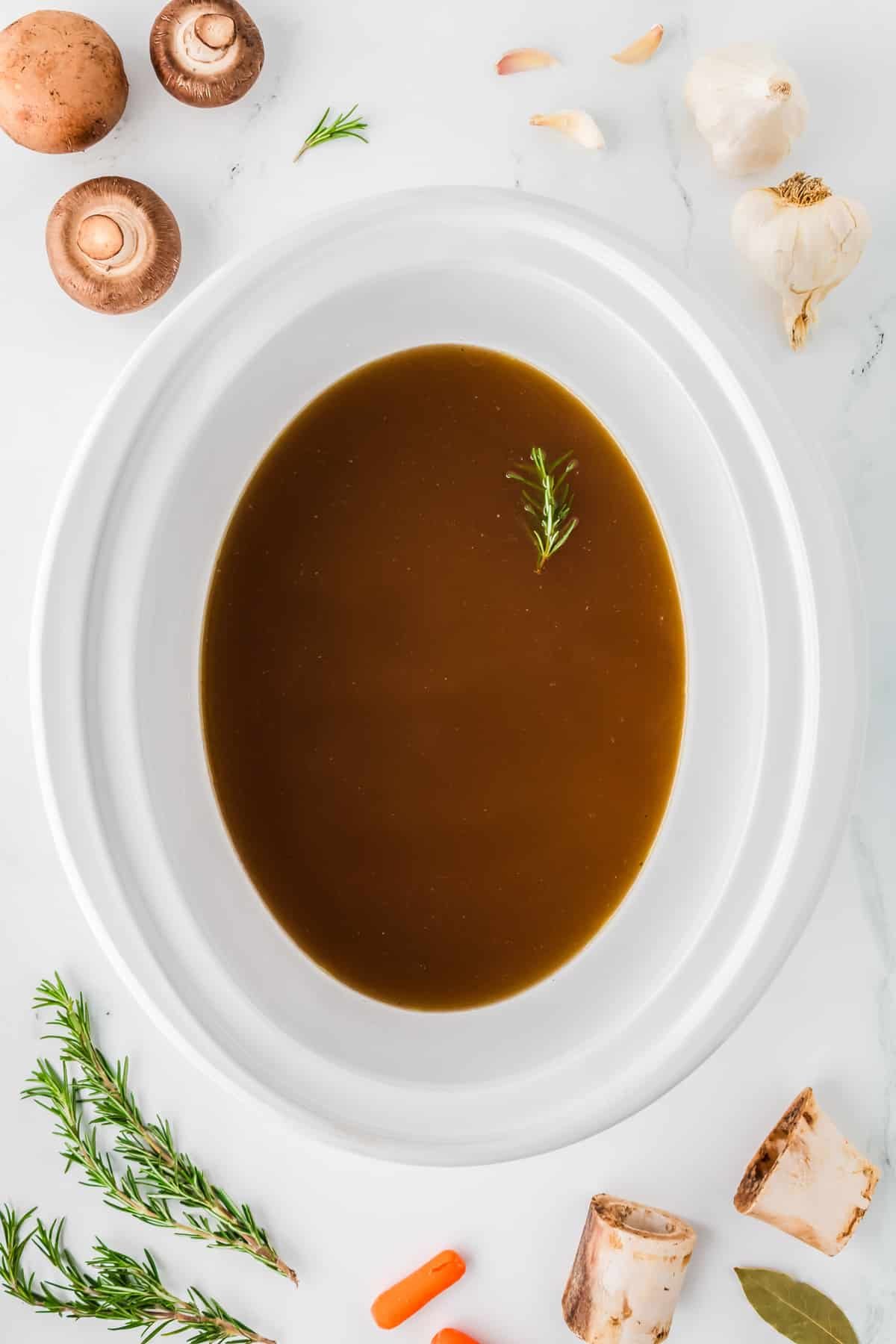
Storing and Freezing Bone Broth
Homemade bone broth can be stored in the refrigerator for 3-4 days. For longer storage, transfer it to a freezer safe container and freeze it for 3-6 months.
For smaller batches, you can freeze the broth in Souper cubes (they come in 2 tablespoon, ½ cup, 1 cup, and 2 cup sizes), or ice cube trays. Then you can just thaw the amount needed for your recipe - easy peasy!
Note about Freezing in Glass Jars
If you want to freeze in glass jars, you have to be quite careful. I've experimented quite a bit with freezing in mason jars and they have a high likelihood of breaking.
The secret is that only the mason jars with straight edges (no neck whatsoever) like the half pint size and 3 cup size (the ones used for asparagus) are safe for freezing. Any other type of glass jar is likely to break.
Expert Tips
- Make it gelatinous. A bone broth that gels well is one that contains lots of gelatin. Using bones with lots of connective tissue (like knuckle bones) increases your chances of making a gelatinous broth, but adding chicken feet is a great way to help things along.
- Use good quality veggies. Any good soup starts with a good broth. That's why I recommend you use vegetables that are fresh and in good shape - not peelings and scraps.
- A second batch. While the first batch of bone broth is always the best, you can reuse the leftover bones to make a second batch. This is a french technique known as Remouillage. You will use the spent bones, but add fresh veggies. Once the broth is strained, simmer it until it reduces by half. It won't gel like the first batch, but it's perfect for using in all of your favorite recipes.

Variations
Chicken bone broth: Substitute the beef bones for 2 chicken carcasses, 2-3 pounds of chicken bones, or an uncooked whole chicken, and substitute the rosemary for parsley. Mushrooms can be left in or out, according to your preference.
Bone marrow broth: Use 3 pounds of beef marrow bones in place of the meaty soup bones.
Turkey broth: Substitute the beef bones for 1 turkey carcass and substitute the rosemary for parsley. Omit the mushrooms.

Recipe FAQs
Ask your butcher or farmer for "soup bones." Meaty bones and those with a lot of cartilage are favored for making bone broth. Neck bones, shank, oxtail, short ribs, and knuckles are all commonly used.
Do I have to roast beef bones prior making broth in the slow cooker?
You do not have to roast the bones before adding them to your slow cooker, but I highly encourage you to do so. The flavor is substantially enhanced when you bake your bones first. Further, uncooked bones tend to produce a less flavorful broth and can also smell while cooking. The extra step is really worth it in the long run!
You can add the vegetables and herbs at the beginning with the bones if desired. But for the best flavor, I like to wait to add mine until the last hour of cooking. Some vegetables and herbs can become bitter if cooked too long which will affect the flavor of your broth.

If you loved this Slow Cooker Beef Bone Broth recipe, let me know by leaving a 5-star review in the recipe card or comment below! You can also tag me on Instagram @littlehomeinthemaking.
📖 Recipe

Slow Cooker Beef Bone Broth
Equipment
- Stainless steel strainer or fine sieve
Ingredients
- 2 tablespoons olive oil or avocado oil
- 1 teaspoon salt
- ½ teaspoon black pepper
- 3 pounds beef soup bones
- 2 tablespoons apple cider vinegar
- 10 cups filtered water
- 1 large onion peeled and quartered
- 8 ounces mushrooms (optional)
- 1 ½ cups chopped carrots or baby carrots
- 2 ribs celery
- 10 garlic cloves peeled
- 1 sprig of fresh rosemary
- 1 bay leaf
Instructions
- Preheat your oven to 375℉ (190ºC).
- In a small bowl, mix the olive oil, salt, and pepper together.
- Place the beef bones on a large baking pan and brush all sides generously with the olive oil mixture.
- Roast the beef bones in the oven for one hour, flipping them halfway through.
- Remove the bones from the baking pan and add them to your slow cooker along with the apple cider vinegar and filtered water.
- Place a lid on the slow cooker and simmer your broth on low for 24 hours.
- Ensure that the ingredients in your slow cooker are always submerged under the liquid. You can add more water if needed to keep them covered.
- During the last hour of simmering, add the mushrooms, carrots, celery stalks, garlic cloves, rosemary, and bay leaf to the broth. Cover the slow cooker and continue simmering for the remaining time.
- Let the broth cool enough to handle and remove the large pieces of bone and vegetables from the broth with a slotted spoon making sure to let any liquid drain back into the slow cooker.
- Use a ladle and fine strainer or sieve to strain the broth as you pour it into canning jars or your preferred storage containers.
- Let the broth come to room temperature and transfer to the fridge to cool. Once your broth has cooled, a layer of fat will form at the top of your container. If desired, you can remove the fat cap and then use or store your bone broth.
Notes
Nutrition
Please note that some of my blog posts here at Little Home in the Making may contain affiliate links. If you make a purchase through these links, I will get a small commission at no additional cost to you. See our disclaimer for more information.











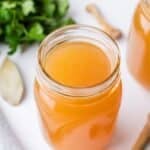




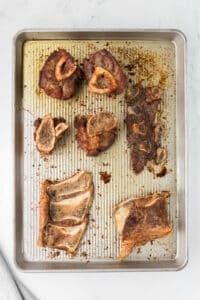

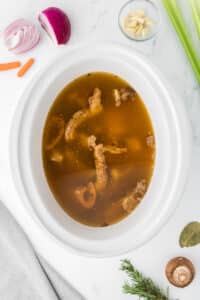




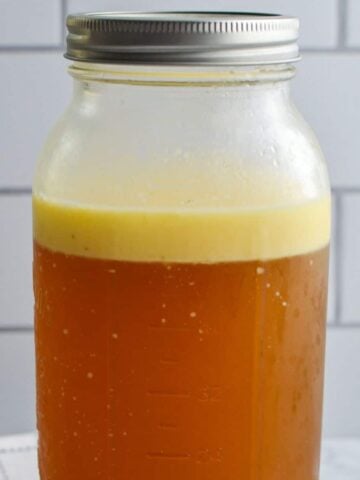


Leave a Reply